
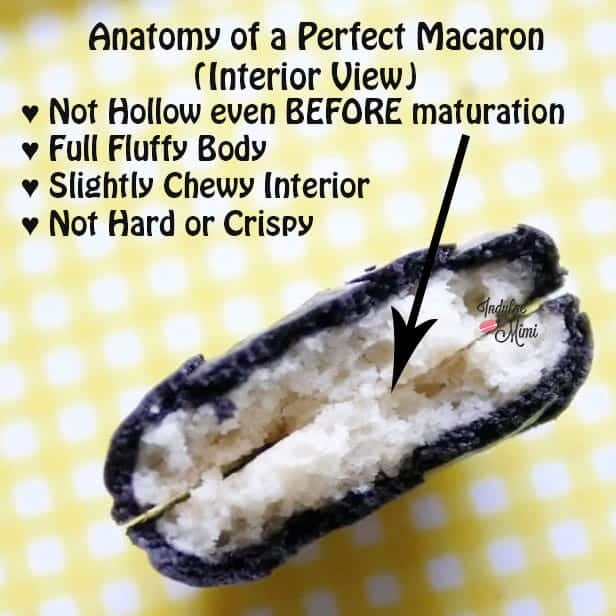
First, I should disclose that there's no such thing as a perfect macaron since we all know that nothing is truly perfect in life 🙂 But many of my readers have asked me what their macarons should be like after baking. I know some also do not live near a bakery where they can buy and taste macarons so their first macarons are they ones they made by themselves! An impressive feat I must say. With that in mind, I created this guide to list some ideal attributes to look for in the search for "ideal or perfect macarons". I put that in quotes because they don't have to look perfect to be good. Don't forget macarons are for eating!
XOXO,
Mimi
Feet:
Perhaps the most talked about and coveted aspect in the art of macaron making. You'll realize that once you've acheived macarons with feet, you don't want just any kind of feet because each type actually reflects what kind of macaron you will have and shows the kind of mistakes you've made. Small unbroken feet are usually a good indication that the macaron is not hollow. Big bubbly feet usually indicates that the insides have been pushed out into the feet causing a hollow macaron.
Examples of "Good Feet":
✓ Ruffled Feet (slight horizontal rise)
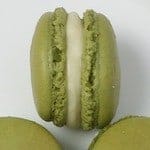


✓ Small Delicate Air Pockets in Feet (clean vertical rise)



✘ Examples of "Bad Feet": (messy broken air pockets/detached feet, excessive horizontal rise (tall feet)/ overly developed feet, no feet)


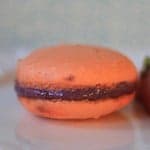
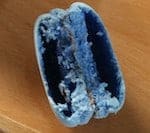
NO HOLLOWS & Texture:
The texture of the macaron should not be super crunchy or crispy like a biscotti. Shells can turn hard from over baking so learn when to stop baking and mature your shells with a higher moisture filling if needed. Stale macarons can also turn hard so make sure to place them in an air tight container in the fridge as they are best eaten within 5-7 days.
Another coveted attribute for any macaron is the absence of hollows. When handled, hollow macarons can be easily broken because there's a big gaping hole inside the shell. As soon as you press into it with your hands, it can easily get crushed. You do not need to fill the macaron shell and bite into it to see that it is fully set with no hollows. This should already be apparent once it cools down and you break it open to see that the shell is not hollow and the insides have not collapsed. Macaron bodies should be fully set with a nice fluffy interior and a crispy egg-shell like exterior. It's the presence of these two contrasting textures which makes this cookie so special. Pressing the bottom of the macarons shell, thereby pushing the insides up to the top, is not the proper way of achieving no hollows. Aim for reducing hollows by baking at the correct temperature (not too low), proper meringue whipping and using the correct folding techniques.

Rise:
The shells should have a healthy rise, not too puffy yet not too flat. A bloated shell that is disproportionate to the whole macaron is often hollow. Fix this by working on your folding technique and making sure that your temperature is just right.
On the flip side, a pancake like macaron is usually a sign that you've over mixed your batter. These aren't too attractive so learn to judge the consistency and know when to stop folding. Remember, the batter should flow slowly like lava and fall a few times on itself like a ribbon.
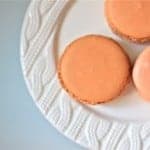
Shape:
This is obvious. Macaron shells should be round. There are several reasons for oddly shaped shells including: over mixed batter, wrong piping techniques and use of parchment paper, either through improper use or just plain bad quality. Invest in a Silpat pan, it will work wonders to keep your shapes round.

Filling:
The filling should not overwhelm the overall construction of the macaron by being over stuffed or under stuffed. Pipe the filling until it reaches close to the edge of the shell but leave some room for it to expand once you assemble the macaron. The filling should not run past the the outer rim of the shell. Too much filling and it will be hard to eat it without the filling squishing out, making for one messy messy treat.

Color:
The tops of the shell should be smooth, not too lumpy and devoid of points or "nipples". Sift your almond flour well to help with attaining super smooth shells. Remove nipples by rapping the tray firmly against the counter after piping.
The colour of the shells should be uniformed and not spotty or browned. To avoid spotty coloring, make sure you're introducing the gel colour into your mixture with enough time left to mix it thoroughly. As for shell browning, make sure you are using your oven correctly. Move your macarons further away from the heat source, lower the temperature or place an empty pan below or above your macarons according to your own situation. Click here to read how to use your oven properly for baking macarons.
[pt_view id="f56aea0p7b"]

Paul says
Hey, I have tried every single way you can possibly try. Soft peaks, hard peaks, low speed, high speed, cream of tartar, no tartar, French method, Italian method, lightly folding the mixture, no macaronage, over macaronage, connection bake, regular bake and everything in between. I only get hollow, I have never gotten anything but good to perfect looking shells that are completely hollow inside. I’ve followed so many tips, including this site. Every single time they turn out hollow, EVERY time, HOLLOW. The only thing is that I’m at altitude, almost 7,000 feet where I’m at. Do you have any more tips than what you’ve laid out in this and the perfect recipe blogs? I’m getting so tired of making inedible hollow Macarons. Terrible texture.
Mimi says
I really wish I knew more about high altitude macaron baking. As I don't live in a high altitude, I don't have any real hands-on experience with this that I can share. Have you read How to Avoid Hollow Macarons? At the current moment, that's all the knowledge I can give in regards to hollows. I hope I can get some more information for you later. I'll have to poll my readers and see if they can provide any more real-life experience on this. Also, Have you tried making the Italian meringue? Would this be more stabile? XOXO, Mimi
Monty says
And yet here you are telling everyone that no hollow macaron is the perfect macaron. You should be able to support that flat out blatant opinion and know-it-all attitude towards perfect macaron and yes even high altitude issues.,
Mimi says
Hi Monty,
I've always supported and cheered on bakers with all different types of macarons results. In my post on these issues, I have always made sure to state macarons are for eating afterall and not just for the aesthetics, I wrote that this is just what an "ideal" macaron should look like for those who are interested to know what attributes one should be looking for when baking them. It would be nice to have a non-hollow macaron but we don't have to be snobs about the issue. I've always told my readers that it takes a long time to make macarons, a lot of love and time goes into it so we should celebrate and enjoy all types of macarons results. What works in one person's kitchen might not work in anothers. I've always recognized I don't have all the answers, I don't live in a high altitude location so I cannot say from my own experience how to bake them in this environment. Everything I share is based on my own experiences which I provide for free to everyone online. With all that is happening in the world right now, I am dismayed that baking - something that is meant to be a sort of stress release and bring a sense of community - can bring on such negative emotions. I hope you do get your answers to high altitude baking. Best of luck.
XOXO,
Mimi
Jennifer C says
I also live at 7000 ft and mine always seem to be hollow. I haven’t tried the Italian method yet, maybe I will at some point and report back. But I will say that once they are filled and matured overnight, the insides do seem to expand and fill most of the hollows. Cheers!
Mimi says
Hi Jennifer,
Thanks for sharing your experience. You're right, a tiny gap is nothing to worry about and does expand a bit after maturation.
Let me know how your Italian ones well.
XOXO,
Mimi
Stacey Youngblood says
Hi Mimi!
Love your troubleshooting advice! Question: How do you get a 2 tone macaron? I noticed them in on the pic with the pink/black macaron and white and black macron.
Thanks!
Stacey
Mimi says
Yes, here is the post to Gender Reveal 2 Coloured Macarons.
Macaron says
The macaron looks great
Mimi says
Thank you so much for your feedback! I hope you get a chance to make it too!
XOXO, Mimi
Lisa says
Hi Mimi,
You said to use 65g of icing sugar with cornstarch, how much cornstarch?
Mimi says
Hi, most powdered sugar in N. America already contains cornstarch. You can use any brand that lists cornstarch as an ingredient.
xoxo,
Mimi
Lisa says
Oh, ok. Good to know. I never paid attention to the ingredients listed on the icing sugar.
Mimi says
No problem. I hope it helps.
XOXO,
Mimi
Casey says
Hi Mimi, my macarons turn out perfectly in every way except for very slight browning around the top edges. The colour is the only thing I need to fix. I bake at 305F for 14 minutes, one rack lower than ‘middle’. I’ve read your posts about properly using the oven and have tried everything I could. Do you have any suggestions?
Mimi says
Hi Casey,
I think you can try a lower temp for 16-18 minutes 🙂
XOXO,
Mimi
Rati says
Hi Mimi,
Whats the standard and mini size of macarons? Seems that all the macaron packaging comes in 5 cm, but not sure whats the standard size is.
Thanks!
Mimi says
hmm... i'm not sure if there is a standard size or not...
xoxo,
Mimi
Lynn Jackson says
If you use convection convert do you start at 325 so it's really 300 or what?
Mimi says
Hi Lynn,
It depends on how your oven converts the convection temperature. For example, mine has a convection convert. If I set it to 300F, the convection conversion will help me reduce it by 25 degrees. Every oven is different. Convection tends to be hotter than the regular setting so yes you can reduce it a bit, then see how it bakes. You'll need to learn how to control the temperature for your own specific oven.
Xoxo
Mimi
nancy says
Hi Mimi
I have had the best success with your macaron recipe, god knows I have tried far too many and wasted too many ingredients. My problem is that no matter how many times I have tried your recipe and followed along with you step by step on Youtube, I always get hollow macarons. I bake at 320*F, for 12 mins, just like you do and I even purchased an oven thermometer. Everything seems to be at opium but still having hollows. HELP!!!!!! FYI, Love your website!!!!
Nancy
Mimi says
Thank you Nancy! Make sure you meringue is strong and use more heat. Either increase your temp or add more time.
XOXO,
Mimi
Ashley says
Mimi,
First, thank you! I am an amateur baker and decided to push my boundaries by mastering a new style. I just, finally, produced my first almost perfect batch! I'm wondering how long I can keep the shells before filling them and what the best way to store them in the meantime would be.
-Ashley
Mimi says
Thank you so much for your note Ashley, you can keep them up to a week in an airtight container in the fridge.
XOXO
Mimi
Lily says
Hi Mimi
My batter is good and my macarons come out smooth and with pretty feet - but always hollow. I know that they're undercooked, but they're browning at the same time. I've tried with the pan on top, cooking for longer times on lesser temps, but they always keep browning before they become fully cooked. Very frustrating! Do you have any other tips?
Mimi says
Hi Lily,
I like that you're baking them at different temps to come to your conclusion. If you are sure that you can achieve a non-hollow macaron (even though its browning), then try to move the tray to a lower position so it won't be so affected by the top heat. Then double pan it so that the bottoms don't get too brown.
XOXO
Mimi
Cecilia says
Hi. Omg I always get hollows. Interior not fluffy. Help!! Do you have a recipe using French method? Currently I'm using this recipe:
75g almond flour
75g powdered sugar
55g aged eggwhites
35g caster sugar
Used a silpat. Tried Baking at 320, 328, 315. All same results. I fold batter just enough where I pipe the tips flatten on their own.
Should I deflate batter?
Thanks!!
Mimi says
Hi Cecelia,
My macaron recipe is on this blog. Just look under macaron recipes or find the button on the front page of this site. The ingredients you listed seem fine. I really believe that the techniques are more important than the ingredients for macarons. You really have to get those techniques right and know your oven. Your oven temperature seems fine but you can try one more temp. Maybe something in the 350 + range. See if that helps. If it doesn't, then it must be something to do with your batter. Remember, bad batters can cause hollows no matter how high your temperature goes.
Elizabeth says
Thanks for all your helpful tips and recipes. A few months ago I discovered the joy of baking macarons and mixing and matching so many possibilities for fillings and shell flavors. I'm having the best time and tons of success. I cannot wait to try some of your recipes, they look wonderful. Last night our new one was lemon flavored mini bear shaped shells with raspberry lemonade filling. So yummy and perfect for Easter. Thanks again for sharing your recipes and tips!
Mimi says
You're welcome, Elizabeth. Thank you so much for dropping me a note ♡ lemon raspberry sounds very interesting! I would love to see your little bears too. Feel free to tag me if you're on IG @indulge.with.mimi Xoxo Mimi
Hieu says
Yes, thank you! I did bake two batches yesterday. One batch at 300 conventional bake, middle rack, with pans above. They baked for 20 minutes with a slight browning. I filled these with blueberry curd and 17 hours later weren't too bad; less hollow shells.
The second batch I changed nothing but the temp; turned it up to 310. These also baked for 20 minutes but turned brown and were crispy! These tested at the same time of maturation, the shell was hollow and cracked when I broke it open! So I will bake another batch in a couple days but will do so at 300 convection bake (setting I used before all this OCD with macarons). Hopefully this will turn out better! Thank you for your help!
Hieu says
Yes, thank you! Your posts are so well written and easy to follow, but at this point I think I've read so many tips and troubleshooting guides I'm all confused! :0) I don't remember having such a tough time when I initially started baking these back in November.
I did bake two batches yesterday. I baked one at 300 conventional bake on the middle rack with pans above. These baked for 20 minutes with little browning and slightly crispy shells! The second batch I baked at 310, all else the same, and these browned. I think I will try again in a couple of days, once my eggs age, and try at 300 on convection bake, which was the original setting I used before all this obsessive compulsiveness started with baking these macarons! Thanks you!
Kat says
You're baking them way too long! 300 degrees and for but 10-13 minutes should prevent them from over baking...make sure you let them "set" for about an hour before baking them. Also let them cool completely before lifting them off a silicone only mat. Parchment paper will not do! :^)
Hieu says
These are beautiful!! I've been frustratingly baking macarons for the past several months and continue to have hollows and browned tops. I'm using a pure convection electric oven at 270 degrees and bake for 15 minutes on the second rack. I can't seem to perfect these little sweets!
Mimi says
Thanks for coming by. Have you read my post on "Correctly using your home oven for baking macarons? I've included the link below. Most bakers prefer to use at least 300 degrees to make sure the shells develop fully to avoid hollows. I like to go 325. Since you have browning, you are probably hesitant to turn up the heat. If you do turn it up, try putting an empty pan on the tray above. Also move the shells down to a lower rack. Play around with it 🙂
Mimi says
Correctly using your ovens for baking macarons.